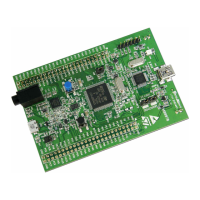About this document PM0214
12/262 PM0214 Rev 9
1 About this document
This document provides the information required for application and system-level software
development. It does not provide information on debug components, features, or operation.
This material is for microcontroller software and hardware engineers, including those who
have no experience of Arm products.
This document applies to Arm
®(a)
-based devices.
1.1 Typographical conventions
The typographical conventions used in this document are:
1.2 List of abbreviations for registers
The following abbreviations are used in register descriptions:
a. Arm is a registered trademark of Arm Limited (or its subsidiaries) in the US and/or elsewhere.
italic Highlights important notes, introduces special terminology, denotes
internal cross-references, and citations.
< and > Enclose replaceable terms for assembler syntax where they appear in
code or code fragments. For example:
LDRSB<cond> <Rt>, [<Rn>, #<offset>]
bold Highlights interface elements, such as menu names. Denotes signal
names. Also used for terms in descriptive lists, where appropriate.
monospace Denotes text that you can enter at the keyboard, such as commands,
file and program names, and source code.
mono
space Denotes a permitted abbreviation for a command or option. You can
enter the underlined text instead of the full command or option name.
monospace italic Denotes arguments to monospace text where the argument is to be
replaced by a specific value.
monospace bold Denotes language keywords when used outside example code.
read/write (rw) Software can read and write to these bits.
read-only (r) Software can only read these bits.
write-only (w) Software can only write to this bit.
Reading the bit returns the reset value.

